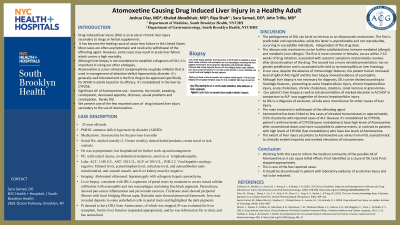Tuesday Poster Session
Category: Liver
P3988 - Atomoxetine Causing Drug-Induced Liver Injury in a Healthy Adult
Tuesday, October 24, 2023
10:30 AM - 4:00 PM PT
Location: Exhibit Hall

Has Audio

Sara Samad, DO
NYC Health + Hospitals, South Brooklyn Health
Brooklyn, NY
Presenting Author(s)
Joshua Diaz, MD1, Khaled Aboelkhair, MD2, Riya Shah, 3, Sara Samad, DO4, Nikolas St. Cyr, MD1, John Trillo, MD5
1South Brooklyn Health, Brooklyn, NY; 2South Brooklyn health, Brooklyn, NY; 3St. George's University, Brooklyn, NY; 4NYC Health + Hospitals, South Brooklyn Health, Brooklyn, NY; 5NYCHHC South Brooklyn Health, Brooklyn, NY
Introduction: Drug induced liver injury (DILI) is a leading cause of liver failure (ALF) in the United States and is still under diagnosed and under reported. Presentation ranges from being asymptomatic to ALF and death. Atomoxetine, a medication used to treat attention-deficit hyperactivity disorder (ADHD) in adults, has a benign side-effect profile, but here we present a case of this well tolerated drug causing liver injury in a healthy patient.
Case Description/Methods: A 25 year old man with ADHD on atomoxetine for 9 months, was referred to Hepatology clinic for incidental abnormal liver function tests (LFTs). His dose was increased 4 months prior to presentation. He had 2 beers weekly, denied herbal supplement and OTC drug use. Lab tests showed ALT 1,140 , AST 526, and ALK 184. US Abdomen was unremarkable. Acute liver injury work up including acetaminophen level, infectious pathogens, autoantibodies and genetic disorders were negative. Liver needle biopsy showed mixed cellular infiltration with eosinophils and macrophages containing fine black pigments, panacinar inflammation and perivenular necrosis. Trichrome stain showed periportal and focal bridging fibrous septa. LFTs trended down and he was discharged with recommendation to discontinue atomoxetine and follow up for LFT monitoring.
Discussion: DILI can be intrinsic or idiosyncratic. The first is predictable and reproducible; the latter unpredictable and occurs in susceptible individuals, independent of drug dose. The liver biopsy and the calculated R-Factor, in our patient suggests chronic hepatocellular injury. There is no test for diagnosis of DILI; thus, history and exclusion of other causes, as done here, is key. In ALF, there is evidence of coagulopathy due to impaired synthetic function, not seen in our patient. The treatment of drug induced hepatotoxicity is withdrawal of the drug. Adjuvant therapy may be considered to aid in treatment based on the drug in question. Although liver biopsy is not necessary for diagnosis it can rule out other causes. Atomoxetine has been linked to elevated LFT’s in approximately 0.5% of patients with reported ALF. The extent of liver injury secondary to this drug varies from mild and asymptomatic to clinically evident hepatitis with elevations of transaminases. Few cases have shown the link between atomoxetine and chronic liver injury. Here its use can be associated with an idiosyncratic chronic liver injury and this co-relation should be considered when using this drug in young healthy patients.
Disclosures:
Joshua Diaz, MD1, Khaled Aboelkhair, MD2, Riya Shah, 3, Sara Samad, DO4, Nikolas St. Cyr, MD1, John Trillo, MD5. P3988 - Atomoxetine Causing Drug-Induced Liver Injury in a Healthy Adult, ACG 2023 Annual Scientific Meeting Abstracts. Vancouver, BC, Canada: American College of Gastroenterology.
1South Brooklyn Health, Brooklyn, NY; 2South Brooklyn health, Brooklyn, NY; 3St. George's University, Brooklyn, NY; 4NYC Health + Hospitals, South Brooklyn Health, Brooklyn, NY; 5NYCHHC South Brooklyn Health, Brooklyn, NY
Introduction: Drug induced liver injury (DILI) is a leading cause of liver failure (ALF) in the United States and is still under diagnosed and under reported. Presentation ranges from being asymptomatic to ALF and death. Atomoxetine, a medication used to treat attention-deficit hyperactivity disorder (ADHD) in adults, has a benign side-effect profile, but here we present a case of this well tolerated drug causing liver injury in a healthy patient.
Case Description/Methods: A 25 year old man with ADHD on atomoxetine for 9 months, was referred to Hepatology clinic for incidental abnormal liver function tests (LFTs). His dose was increased 4 months prior to presentation. He had 2 beers weekly, denied herbal supplement and OTC drug use. Lab tests showed ALT 1,140 , AST 526, and ALK 184. US Abdomen was unremarkable. Acute liver injury work up including acetaminophen level, infectious pathogens, autoantibodies and genetic disorders were negative. Liver needle biopsy showed mixed cellular infiltration with eosinophils and macrophages containing fine black pigments, panacinar inflammation and perivenular necrosis. Trichrome stain showed periportal and focal bridging fibrous septa. LFTs trended down and he was discharged with recommendation to discontinue atomoxetine and follow up for LFT monitoring.
Discussion: DILI can be intrinsic or idiosyncratic. The first is predictable and reproducible; the latter unpredictable and occurs in susceptible individuals, independent of drug dose. The liver biopsy and the calculated R-Factor, in our patient suggests chronic hepatocellular injury. There is no test for diagnosis of DILI; thus, history and exclusion of other causes, as done here, is key. In ALF, there is evidence of coagulopathy due to impaired synthetic function, not seen in our patient. The treatment of drug induced hepatotoxicity is withdrawal of the drug. Adjuvant therapy may be considered to aid in treatment based on the drug in question. Although liver biopsy is not necessary for diagnosis it can rule out other causes. Atomoxetine has been linked to elevated LFT’s in approximately 0.5% of patients with reported ALF. The extent of liver injury secondary to this drug varies from mild and asymptomatic to clinically evident hepatitis with elevations of transaminases. Few cases have shown the link between atomoxetine and chronic liver injury. Here its use can be associated with an idiosyncratic chronic liver injury and this co-relation should be considered when using this drug in young healthy patients.
Disclosures:
Joshua Diaz indicated no relevant financial relationships.
Khaled Aboelkhair indicated no relevant financial relationships.
Riya Shah indicated no relevant financial relationships.
Sara Samad indicated no relevant financial relationships.
Nikolas St. Cyr indicated no relevant financial relationships.
John Trillo indicated no relevant financial relationships.
Joshua Diaz, MD1, Khaled Aboelkhair, MD2, Riya Shah, 3, Sara Samad, DO4, Nikolas St. Cyr, MD1, John Trillo, MD5. P3988 - Atomoxetine Causing Drug-Induced Liver Injury in a Healthy Adult, ACG 2023 Annual Scientific Meeting Abstracts. Vancouver, BC, Canada: American College of Gastroenterology.

